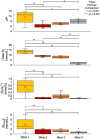pH and thiosulfate dependent microbial sulfur oxidation strategies across diverse environments
- PMID: 39101034
- PMCID: PMC11294248
- DOI: 10.3389/fmicb.2024.1426584
pH and thiosulfate dependent microbial sulfur oxidation strategies across diverse environments
Abstract
Sulfur oxidizing bacteria (SOB) play a key role in sulfur cycling in mine tailings impoundment (TI) waters, where sulfur concentrations are typically high. However, our understanding of SOB sulfur cycling via potential S oxidation pathways (sox, rdsr, and S4I) in these globally ubiquitous contexts, remains limited. Here, we identified TI water column SOB community composition, metagenomics derived metabolic repertoires, physicochemistry, and aqueous sulfur concentration and speciation in four Canadian base metal mine, circumneutral-alkaline TIs over four years (2016 - 2019). Identification and examination of genomes from nine SOB genera occurring in these TI waters revealed two pH partitioned, metabolically distinct groups, which differentially influenced acid generation and sulfur speciation. Complete sox (csox) dominant SOB (e.g., Halothiobacillus spp., Thiomonas spp.) drove acidity generation and S2O3 2- consumption via the csox pathway at lower pH (pH ~5 to ~6.5). At circumneutral pH conditions (pH ~6.5 to ~8.5), the presence of non-csox dominant SOB (hosting the incomplete sox, rdsr, and/or other S oxidation reactions; e.g. Thiobacillus spp., Sulfuriferula spp.) were associated with higher [S2O3 2-] and limited acidity generation. The S4I pathway part 1 (tsdA; S2O3 2- to S4O6 2-), was not constrained by pH, while S4I pathway part 2 (S4O6 2- disproportionation via tetH) was limited to Thiobacillus spp. and thus circumneutral pH values. Comparative analysis of low, natural (e.g., hydrothermal vents and sulfur hot springs) and high (e.g., Zn, Cu, Pb/Zn, and Ni tailings) sulfur systems literature data with these TI results, reveals a distinct TI SOB mining microbiome, characterized by elevated abundances of csox dominant SOB, likely sustained by continuous replenishment of sulfur species through tailings or mining impacted water additions. Our results indicate that under the primarily oxic conditions in these systems, S2O3 2- availability plays a key role in determining the dominant sulfur oxidation pathways and associated geochemical and physicochemical outcomes, highlighting the potential for biological management of mining impacted waters via pH and [S2O3 2-] manipulation.
Keywords: pH; sox genes; sulfur oxidizing bacteria (SOB); tailings impoundments; thiosulfate.
Copyright © 2024 Twible, Whaley-Martin, Chen, Colenbrander Nelson, Arrey, Jarolimek, King, Ramilo, Sonnenberg, Banfield, Apte and Warren.
Conflict of interest statement
LR and HS were employed by EcoReg Solutions. The remaining authors declare that the research was conducted in the absence of any commercial or financial relationships that could be construed as a potential conflict of interest.
Figures





Similar articles
-
Microbial sulfur cycling determinants and implications for environmental impacts.Chemosphere. 2025 Mar;372:144084. doi: 10.1016/j.chemosphere.2025.144084. Epub 2025 Jan 14. Chemosphere. 2025. PMID: 39798717
-
O2 partitioning of sulfur oxidizing bacteria drives acidity and thiosulfate distributions in mining waters.Nat Commun. 2023 Apr 10;14(1):2006. doi: 10.1038/s41467-023-37426-8. Nat Commun. 2023. PMID: 37037821 Free PMC article.
-
The Potential Role of Halothiobacillus spp. in Sulfur Oxidation and Acid Generation in Circum-Neutral Mine Tailings Reservoirs.Front Microbiol. 2019 Mar 8;10:297. doi: 10.3389/fmicb.2019.00297. eCollection 2019. Front Microbiol. 2019. PMID: 30906283 Free PMC article.
-
Sulfur Oxidation in the Acidophilic Autotrophic Acidithiobacillus spp.Front Microbiol. 2019 Jan 10;9:3290. doi: 10.3389/fmicb.2018.03290. eCollection 2018. Front Microbiol. 2019. PMID: 30687275 Free PMC article. Review.
-
Roles, mechanism of action, and potential applications of sulfur-oxidizing bacteria for environmental bioremediation.Sci Total Environ. 2022 Dec 15;852:158203. doi: 10.1016/j.scitotenv.2022.158203. Epub 2022 Aug 28. Sci Total Environ. 2022. PMID: 36044953 Review.
Cited by
-
Thiocapsa, Lutimaribacter, and Delftia Are Major Bacterial Taxa Facilitating the Coupling of Sulfur Oxidation and Nutrient Recycling in the Sulfide-Rich Isinuka Spring in South Africa.Biology (Basel). 2025 May 5;14(5):503. doi: 10.3390/biology14050503. Biology (Basel). 2025. PMID: 40427692 Free PMC article.
References
-
- Akcil A., Koldas S. (2006). Acid mine drainage (AMD): causes, treatment and case studies. J. Clean. Prod. 14, 1139–1145. doi: 10.1016/J.JCLEPRO.2004.09.006 - DOI
-
- Arce-Rodríguez A., Puente-Sánchez F., Avendaño R., Martínez-Cruz M., de Moor J. M., Pieper D. H., et al. . (2019). Thermoplasmatales and sulfur-oxidizing bacteria dominate the microbial community at the surface water of a CO 2-rich hydrothermal spring located in Tenorio volcano national park. Costa Rica. Extremophiles 23, 177–187. doi: 10.1007/s00792-018-01072-6 - DOI - PubMed
LinkOut - more resources
Full Text Sources
Miscellaneous

